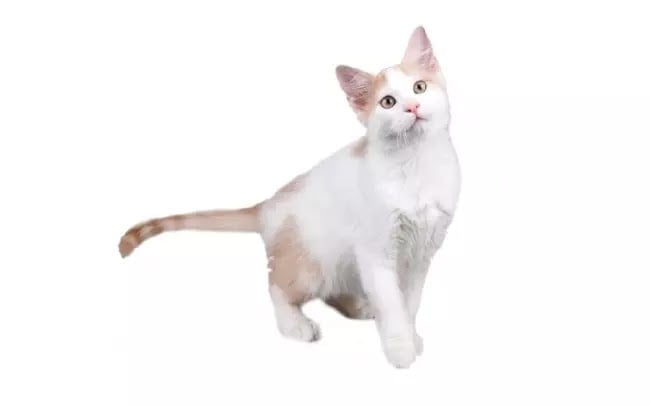The Pixie Bob cat is a medium-sized breed known for its wild-looking appearance and friendly personality. It resembles a bobcat with its short tail and ear tufts. Despite looking wild, Pixie Bobs are gentle companions who love human interaction. They have a powerful and well-proportioned body. They are intelligent and can be trained easily. Pixie Bobs have a beautiful coat with lynx tipping or tabby markings. Overall, they are captivating and sociable feline companions.
History
Carol Ann Brewer, a resident of Mount Baker, Washington, saved a male stray who she named Keba in 1985. Keba was a large boy who reached Brewer’s knees. Shortly after being brought home by Brewer, Keba had a child with a domestic shorthair neighbor. Brewer kept a female bob-tailed kitten with bobcat spots from the subsequent litter, and she was given the name Pixie. Pixie will eventually establish the Pixie Bob Cat breed and bear its name. The International Cat Association granted the Pixie-bob breed preliminary recognition in 1993 and champion status in 1998.

Size
Although larger males have occasionally been observed, both genders can reach heights of 12 to 13 inches. Pixie Bob Cats are extremely strong and thick-set cats. While a male’s top weight is typically 14 pounds, there have been males as hefty as 25 pounds documented. They have a 15-year lifespan on average.
Personality
The Pixie Bob cat is sociable and playful and gets along well with both human and animal family members. This bright and curious cat, who is fiercely attached to its owners, would especially enjoy becoming engaged in family activities, such as making the bed or filing taxes, as a Pixiebob loves to “help.” Despite its helpfulness, the Pixiebob is a very chill cat who enjoys cuddling up on laps and sleeping in beds. They can also be very talkative, expressing themselves through a variety of chirrups, chirps, beeps, and grumbles.
Food
If you acquire a Pixie Bob kitten from a breeder, they will provide you with a feeding schedule. To prevent stomach issues, it is crucial to follow the same pattern and feed the same kitten food. Although older cats are not typically known to be picky eaters, this does not permit feeding them a food of poorer quality. It’s preferable to feed an adult cat numerous times throughout the day, making sure the food is of high quality and covers all of their nutritional needs. This is crucial as cats age. Make sure your Pixie Bob cat always has access to fresh water, and think about getting them a water fountain since many cats love to drink moving water.
Grooming
Both shorthair and longhair pixie-bobs are available. The longhair has a coat that is up to 2 inches long and has a softer, silkier feel than the shorthair, which has a thick double coat. Both varieties can shed a lot. You should brush your Pixie Bob Cat at least twice a week with a rubber or metal brush made for the length of your cat’s fur to keep shedding under control and avoid mats or hairballs. Trim the nails on your cat, and provide them a scratching post. By regularly brushing your cat’s teeth, you may promote good dental health.

Training
The highly intelligent Pixie Bob cat shouldn’t provide too many difficulties during training. This breed is renowned for being quick to pick up new skills, simple to housebreak, and even trainable to walk on a leash if required. Avoid penalizing your Pixie-bob when they make mistakes like taking the restroom somewhere other than the litterbox. This only makes things worse and jeopardizes the unique connection you share with your Pixie-bob. Despite their reputation for being simple to train, some could simply require a bit more time than others. The Pixie-bob won’t likely object to training because it’s just another opportunity to hang out with you!
Health
Pixie-Bobs are generally healthy and not prone to many diseases as a breed. Because the breed is routinely outcrossed, inbreeding-related health issues are less likely to occur. A Pixie Bob cat still has a few health problems that could occur. A small number of Pixie-Bobs have trouble giving birth to their litters, which could have negative health effects. We remove these Pixie-Bobs from breeding in an effort to lessen this problem. Pixie-Bobs stand out because they are polydactyl. Cats who are polydactyl have more fingers on their paws than usual. If you own a Pixie-Bob cat, luck might be on your side since polydactyl cats are thought to be lucky.
Bottom Line
Pixie-Bobs’ canine-like characteristics have led to them being referred to as the family’s “watch-dogs.” They occasionally act in a grandfatherly manner of protection for the people they care about rather than an aggressive manner. Pixie Bob cat breeds are widely renowned for getting along with well-behaved kids and will take pleasure in some quality playtime or cuddling. Dogs are also a wonderful choice for Pixie-Bobs because they tend to have similar personalities.
Pixie-Bobs is never against a feline companion when it comes to other cats. Just make sure to safely introduce two cats to one another by going through the right steps. By doing this, you can prevent them from acting aggressively owing to their territorial nature.








